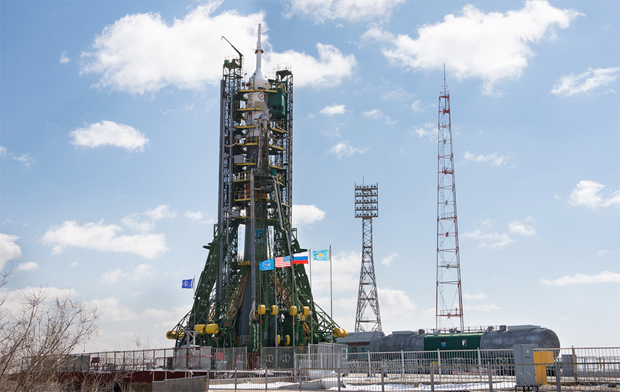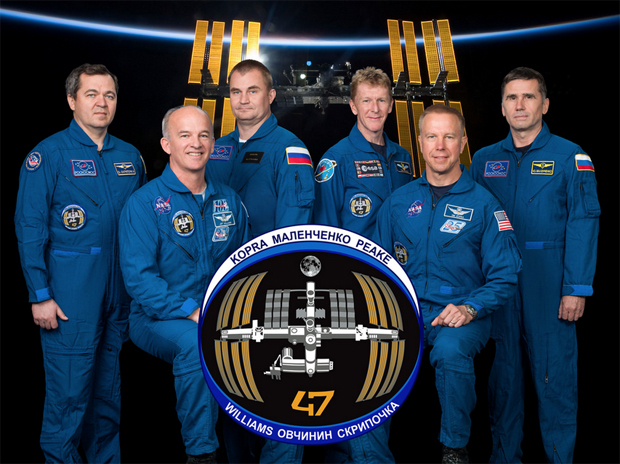Next space station crew set for Friday launch, docking
With Scott Kelly back on Earth after a record-setting voyage, his NASA backup, three-flight veteran Jeffrey Williams, is poised for launch from Kazakhstan Friday to kick off a six-month stay aboard the International Space Station.
The Soyuz TMA-20M/46S spacecraft, with rookie commander Alexey Ovchinin at the controls, flanked on the right by Williams and on the left by flight engineer Oleg Skripochka, is set for liftoff from the Baikonur Cosmodrome at 5:26:39 p.m. EDT (GMT-5; 3:26 a.m. Saturday local time).
That's roughly the moment Earth's rotation carries the launch pad into the plane of the space station's orbit, which is required for the Soyuz to catch up with the outpost.
"It's quite a ride," Williams said of the Soyuz. "It's better than an E-ticket ride at Disneyland, I guess you could say. It only takes nine minutes to get to orbit, and in that time, you're going 17,500 miles an hour. So it's quite a ride!"
If all goes well, Ovchinin will oversee an automated four-orbit rendezvous, docking at the space station's upper Poisk module around 11:11 p.m. Friday. Standing by to welcome their new crewmates aboard will be Expedition 47 commander Timothy Kopra, British astronaut Timothy Peake and cosmonaut Yuri Malenchenko, who were launched to the outpost aboard the Soyuz TMA-19M/45S ferry ship on Dec. 15.
They've had the station to themselves since Kelly, fellow long-duration crew member Mikhail Kornienko and Soyuz TMA-18M commander Sergey Volkov departed and returned to Earth March 1.
Williams, 58, is a three-flight veteran with a total of 362 days in space, including three spacewalks. His first flight came in 2000 during the initial stages of space station construction. He spent 183 days aboard the station in 2006 and another 169 days in 2009-10, serving as commander of Expedition 22.
More recently, he served as Kelly's backup for the longest flight in NASA history, setting the stage for launch Friday on his fourth spaceflight.
During his upcoming stay in space, Williams will move ahead of Kelly on the list of most experienced space fliers, with 534 days off planet over four flights when he returns to Earth in September. Kelly's total is 520 days, including the just-completed 340-day mission, a mark Williams will pass on Aug. 24.
"I didn't expect, realistically, to fly again," Williams said in an interview. "I'm at the right end of the spectrum of a typical career. It was really the one-year flight that put me back in the queue."
NASA was looking for volunteers for the long duration flight and "it took until my wife ... said if you think you need to do this, then I'll support it." At that point, Williams told NASA management he was available.
"It ended up a very small number of (volunteers), which included Scott Kelly," he said. "Scott got the prime, I got the backup. I was happy with that arrangement, but that's what put me in the pipeline to go back again."
In training for about two-and-a-half years, Williams, a West Point graduate, military parachute jumpmaster and test pilot, said he focused primarily on refresher courses to get him back up to speed on current systems aboard the station. He said he was eager to jump back into the lab's research work, including ongoing medical studies to learn more about the effects of weightlessness.
"We've got a wide variety of science that's ongoing in the space station, and there's no exception during my coming stay," he said. "I think what's most interesting to me, because it supports future exploration, is the study of ourselves.
"We're guinea pigs up there, so we're doing a lot of studies on the human body, trying to understand the impacts of the environment on us so we can develop countermeasures. Those end up in some ways being the more challenging ones, but they're also the more interesting ones personally."
Asked what inspired him to be an astronaut, Williams credited his father, a high school history teacher and guidance counselor, and a sixth-grade science teacher who "significantly influenced me."
Ovchinin, making his first flight, also got the space bug as a child.
"What prompted me to become a cosmonaut, it was other Russian cosmonauts, because after every launch and landing there was wide coverage on Russian TV and in Russian newspapers and it was presented in such a way I really wanted to become a cosmonaut. I made my decision when I was about seven or eight years old."
While his flight is the "fulfillment of my lifelong dream," Ovchinin said his wife and eight-and-a-half-year-old daughter "are concerned because I'm flying into space."
"But this is the way I have chosen, and I'm going to continue on this path," he said. "They'll just have to put up with it!"
Friday's launching will cap a busy few weeks at the sprawling Baikonur Cosmodrome, following a March 11 launch abort for an Earth-observation satellite, a successful re-launch the next day and launch of the European Space Agency's multi-billion-dollar ExoMars spacecraft March 14.
High winds at the Kazakh spaceport delayed Soyuz flight preparations earlier in the week, but Russian engineers said they would have no problem making up lost time.
Once in orbit, Williams and his crewmates will face a challenging six months. Orbital ATK plans to launch a Cygnus cargo ship March 22 aboard an Atlas 5 rocket that will deliver more than 7,000 pounds of supplies and equipment, including 2,500 pounds of food, clothing and other crew equipment and 1,700 pounds of science gear.
A Russian Progress supply ship is scheduled for launch from Baikonur on March 31, followed by launch of a SpaceX Dragon cargo capsule from Cape Canaveral around April 8.
The SpaceX Dragon, along with carrying more needed supplies, also will deliver an inflatable module built by Bigelow Aerospace, owned by motel magnate Robert Bigelow, that could provide a low-cost way to supply modules for commercial space stations or NASA deep space missions.
The Bigelow Expandable Activity Module, or BEAM, will be attached to a port on the station's Tranquility module. Once locked in place, the collapsed module will be "blown up," or pressurized. Because the technology is unproven, the astronauts will leave the hatches closed most of the time, floating inside only occasionally to replace sensors and inspect the module.
"We're very excited anticipating the BEAM coming up on SpaceX and deploying it as an experiment," Williams said. "BEAM is a technology demonstration. It's an inflatable module, so it's volume is smaller when it launches than when it's utilized in space. It takes less room, and that technology has great promise for the launching of future spacecraft."
Once in place, BEAM will be pressurized "with air tanks that are internal to the BEAM module itself," Williams said. "After it's pressurized, we'll equalize the pressure, ingress (and) install some sensors for data collection. The nominal configuration, though, will be hatches closed. ... We'll see how the performance of that new technology turns out."
Another major milestone for Williams and his crewmates is launch of another SpaceX cargo ship in June or July that will deliver a docking mechanism, the first of two needed to support linkups by commercial crew ferry ships being built by Boeing and SpaceX. Both companies hope to begin operational flights starting in late 2018.
The international docking adapter, or IDA, coming up in June will take the place of one that was destroyed last year when a SpaceX Falcon 9 rocket carrying space station-bound supplies suffered a catastrophic launch failure. A replacement IDA is being built by Boeing.
Earlier space station crews have carried out a half-dozen spacewalks to install power lines, data cables and communications gear needed by the new spacecraft and their IDAs. The IDA carried up this summer will be attached to the Harmony module's forward docking port in July while the second will be mounted on the module's upper hatchway next year.
Getting the first IDA to the station "is a significant milestone as we all anticipate the first flight and subsequent flights of commercial crew vehicles from the two companies, which will significantly expand the capability we have for access to low-Earth orbit and specifically the space station," Williams said.
Since the space shuttle's retirement in 2011, NASA has been forced to rely on the Russians to carry U.S. and partner astronauts to and from the space station. NASA managers had hoped to have U.S.-built ferry ships up and running by now, but funding shortfalls have stretched out development.
"The impression out there is that we're dependent on the Russian side for access, and certainly there's some truth in that," Williams said. "But I like to put it a little bit differently. The Russian side has been great partners with us on the ISS program. We chose to retire the shuttle, and there was rationale to do that, and it's taken some time for the next generation of vehicles to get there. That has resulted in a gap.
But Williams repeated that the Russians "have been very good partners, stepping up to the plate to fill the gap we didn't anticipate in the beginning."
"When we do begin flying commercial crew vehicles, it's not going to be (a case of) now the U.S. side is doing one thing and the Russian side is doing another. The vehicles will complement one another to sustain the ISS program out to the end of its life. It's probably fair to assume there will continue to be one U.S. crew member on every Soyuz and one Russian cosmonaut on every U.S. commercial vehicle after that."
That's because station crew members are assigned to specific vehicles, which serve as lifeboats between launch and landing. A medical emergency or some other problem that might force one ferry ship to depart, along with the crew that launched aboard it, could leave the station without a Russian or American crew member aboard to operate that nation's systems.
"From an operational point of view, we need to do that (for) a contingency when we need to go down to a one-vehicle crew on board space station," Williams said, "in other words three or four people. We have to have the expertise required for the systems on both ends of the space station."
Launch vehicles aside, Williams said NASA and Roscosmos, the Russian federal space agency, need each other to survive, and that the partnership will pay off down the road when planning for eventual flights to the moon or Mars begins.
"I believe that if we were not partners with Russia, specifically in the International Space Station, neither of our countries would be flying people in space today," he said. "That being said, it's very likely that future endeavors, especially big endeavors, whether it be going back to the moon (or) Mars, if you look at the scope of doing that, I can't imagine ever doing that outside of an international partnership."


